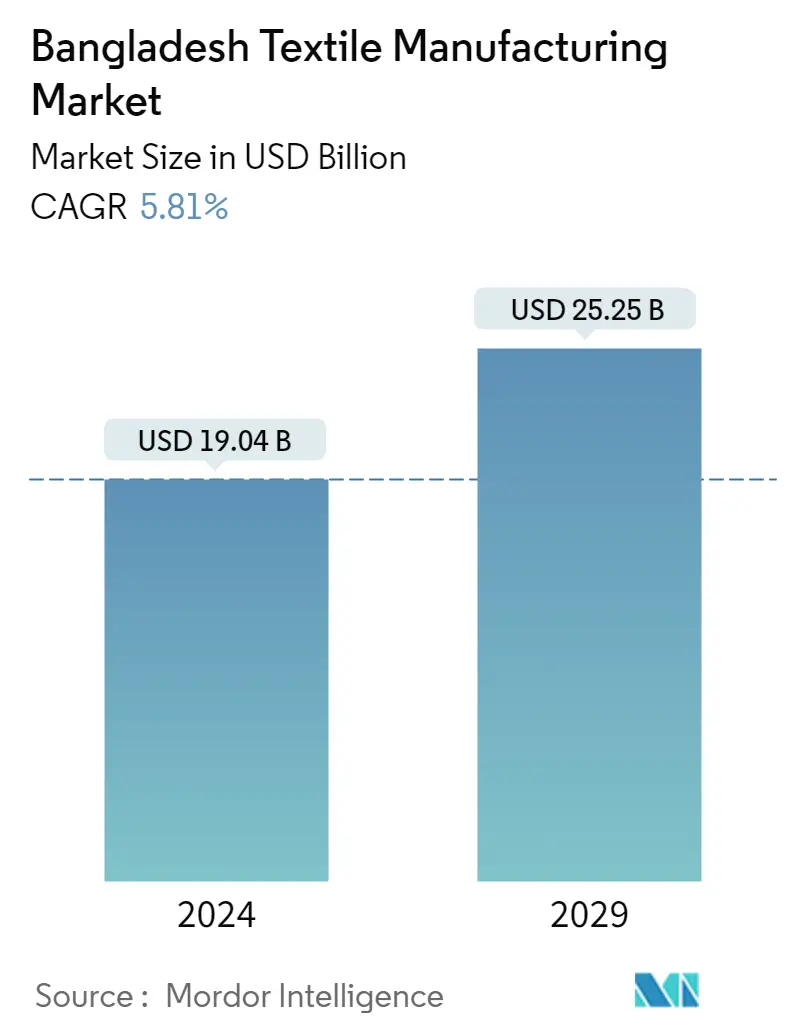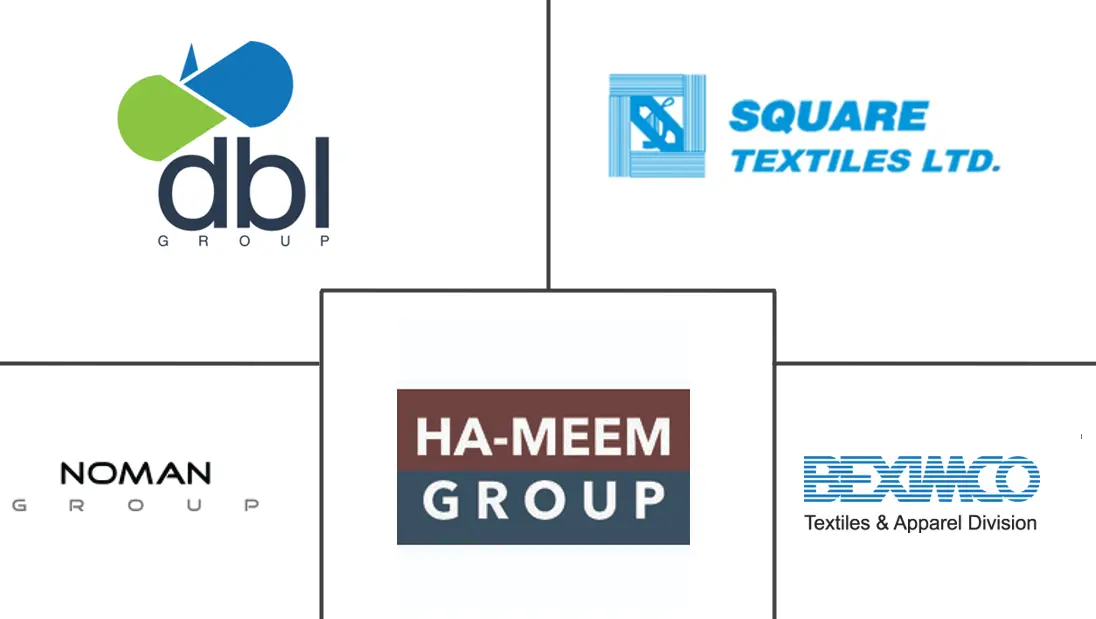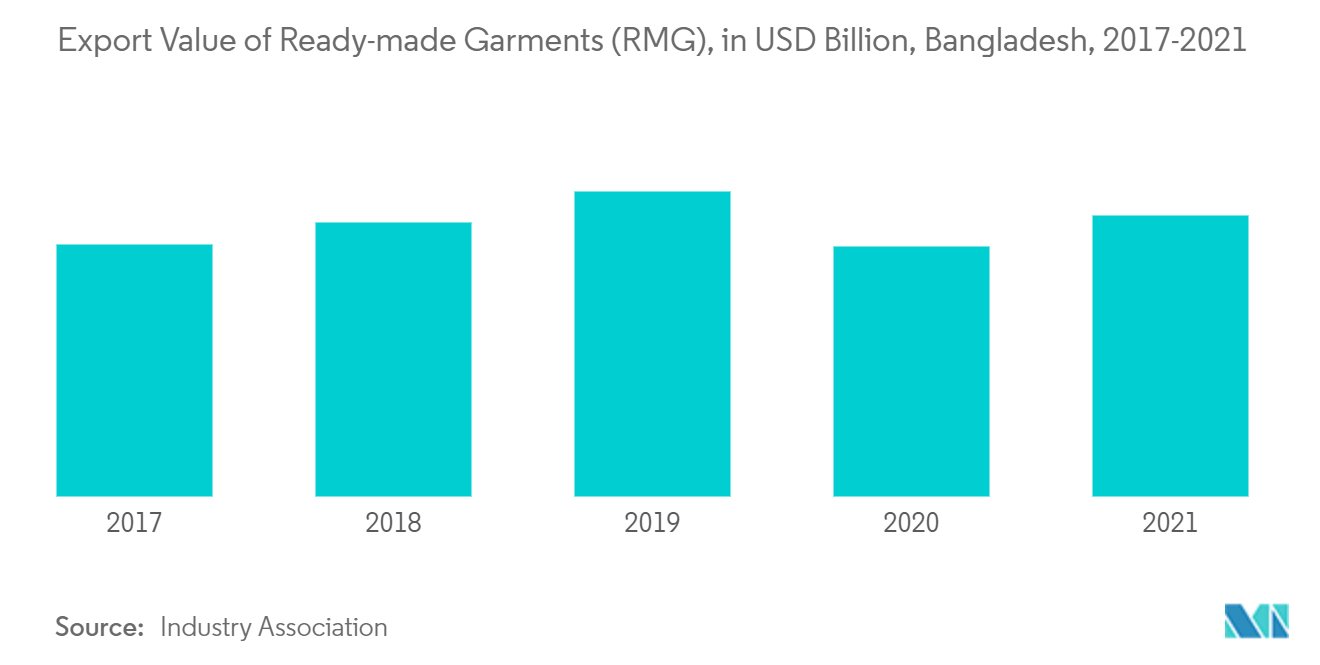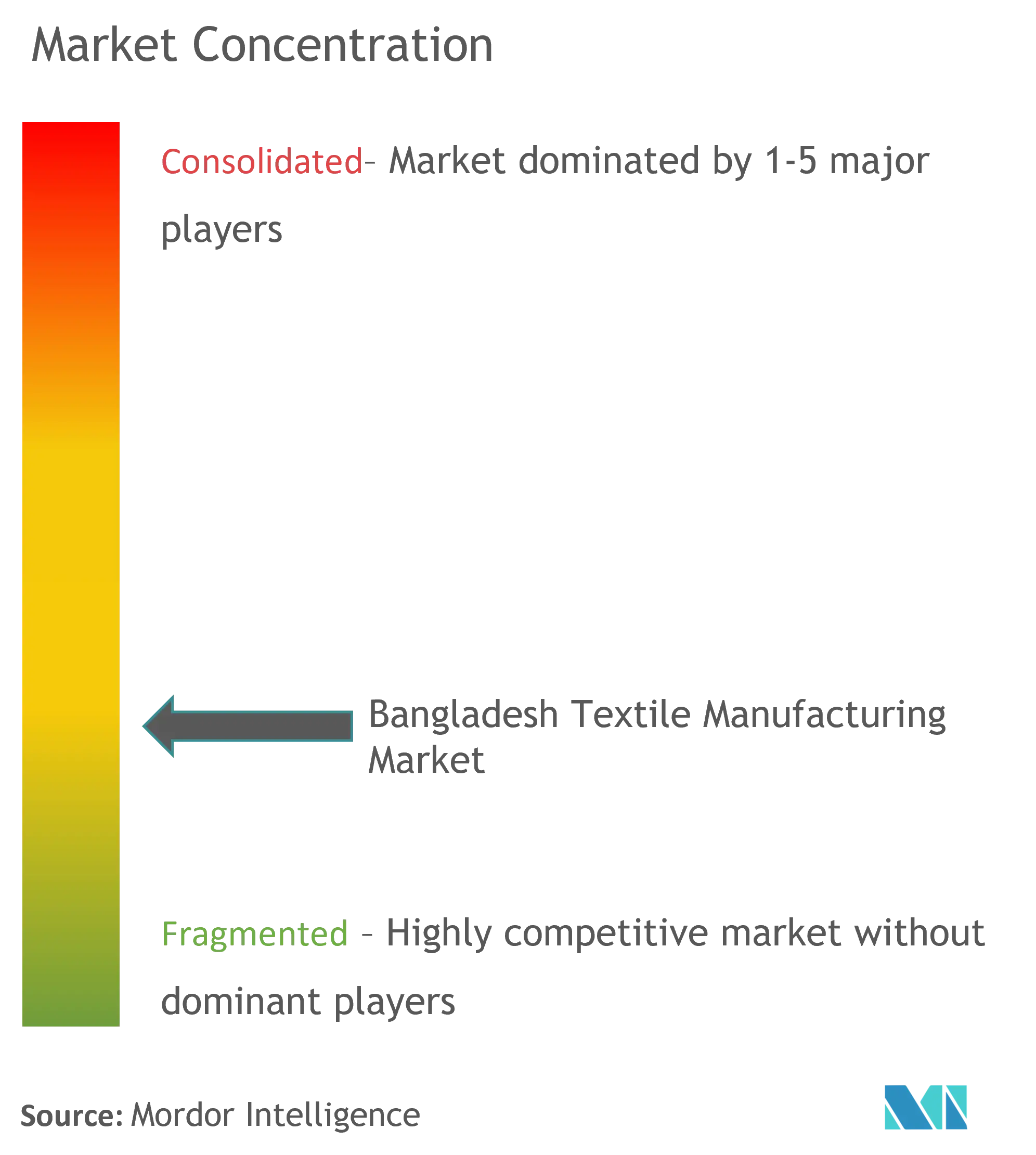Bangladesh Textile Market Size

| Study Period | 2019 - 2029 |
| Base Year For Estimation | 2023 |
| Market Size (2024) | USD 19.04 Billion |
| Market Size (2029) | USD 25.25 Billion |
| CAGR (2024 - 2029) | 5.81 % |
| Market Concentration | Low |
Major Players
*Disclaimer: Major Players sorted in no particular order |
Bangladesh Textile Market Analysis
The Bangladesh Textile Manufacturing Market size is estimated at USD 19.04 billion in 2024, and is expected to reach USD 25.25 billion by 2029, growing at a CAGR of 5.81% during the forecast period (2024-2029).
- COVID-19 had a severe impact on the textile manufacturing industry. In the first half of 2020, the industry faced a shortage of labor supply and logistics difficulty due to the country's lockdown. COVID-19 also impacted the sales of textiles due to the closure of supermarkets and other physical retail stores as per the government's strict restrictions.
- However, the COVID-19 crisis accelerated e-commerce sales in the market studied. Still, in FY 2020-21, Bangladesh's ready-made garment (RMG) exports grew by 12.55% to USD 31.46 billion (out of USD 38.76 billion in total exports) as demand in major markets in Europe and North America began to recover from the COVID-19 pandemic.
- The textile sector contributes more than 13% of Bangladesh's GDP. Over 84% of the export earnings come from textiles and textile-related products. The country invested around USD 15 billion in the primary textile sector. The Primary Textile Sector (PTS) meets approximately 85-90% of the yarn demand for knit RMG and 35-40% for woven RMG.
- The demand for local fabric and yarn for handlooms is also met by the Primary Textile Sector (PTS). The Bangladesh Textile Mills Association (BTMA) is the national trade organization representing yarn and fabric manufacturers and textile product processors in the country in the private sector. The BTMA has 510 yarn manufacturing mills, 901 fabric manufacturing mills, and 317 dyeing, printing, and finishing mills as members, totaling 1,728 member mills.
- According to statistics from the Export Promotion Bureau of the Government of Bangladesh, RMG exports were up by 13.4% from July to September 2022, at USD 10.27 billion from USD 9.06 billion a year earlier. The figure beat Bangladesh's export target of USD 10.02 billion for the quarter. Knitwear exports were up by 9.4% to reach USD 5.65 billion from USD 5.16 billion, beating a target of USD 5.5 billion. Exports of woven garments jumped by nearly 19% to reach USD 4.62 billion, up from USD 3.9 billion a year earlier. This trend greatly benefited the textile manufacturing sector in the country. However, Bangladesh RMG exporters are facing hurdles with declining shipments to and payments from Russia due to the ongoing Russia-Ukraine war.
- Many garment suppliers are not receiving export receipts as several Russian banks have been banned from using SWIFT, the global payments messaging network. Around 150 apparel exporters from Bangladesh have been keenly tapping the emerging Russian market. Bangladesh-Russia trade is valued at more than USD 1 billion and is growing. Many exporters stated that their goods are stuck at Chattogram port because shipping lines are not ready to take them on board. Others have reported that their documents have been sent back from Hungary due to the SWIFT ban. These factors are negatively affecting the market.
Bangladesh Textile Market Trends
This section covers the major market trends shaping the Bangladesh Textile Manufacturing Market according to our research experts:
Increasing Demand for Natural Fibers
Natural fiber composites are relatively lighter and stronger than conventional fibers. Thus, they find extensive applications in the automotive industry for interiors and exteriors. Natural fibers obtained from plants and animals include cotton, silk, linen, wool, hemp, jute, and cashmere. These fibers are widely used to manufacture garments, apparel, construction materials, medical dressings, and the interiors of automobiles. Silk is used in upholstery and apparel, as it is available in both variations: fine and coarse. Wool and jute are used as textile materials for their resilience, elasticity, and softness. Despite lower production volume, the requirement for raw cotton for the textile industry is very high. In 2022, approximately 8.5 million 480-pound bales of cotton were consumed in Bangladesh, an increase from 2020, when just over 6.9 million 480-pound bales of cotton were consumed in Bangladesh. The increasing consumption of natural fibers, such as cotton, silk, wool, and jute, will likely drive the Bangladeshi textile manufacturing market during the forecast period.

Clothing Export is the Main Growth Driver
Currently, Bangladesh is the second-largest clothing exporter in the world, behind China. There are more than 4,500 factories presently operating within the industry, with most of them located around Dhaka. The garment industry in Bangladesh continues to drive economic growth for the country, contributing a 6% average annual growth rate since 2007. The garment industry accounts for about 80% of all export earnings achieved by Bangladesh each year. Europe receives 61% of the exports that are created by the Bangladesh garment industry every year. About 75% of Bangladesh's manufacturing employment is held within the clothing and textile sector. At the same time, up to 75% of the value-added amount generated by the industry goes to retailers or producers. Emerging export markets for Bangladesh represent 15% of the total exports the garment industry can achieve. The emerging markets include China, Brazil, Japan, and Australia.
In comparison, the United States accounts for 21% of the exports achieved by the industry each year. For knit clothing, the United States leads the export market, accounting for 37% of the purchases. Germany and the United Kingdom account for 24% of total knit purchases. Outside of Europe and the United States, only Canada provides more than USD 1 billion in export revenues to the Bangladeshi garment industry each year.
In 2021, the share of ready-made garment (RMG) exports in Bangladesh amounted to approximately 81.16% of the total exports. Although a decrease from the previous year, this was an increase from 2012, when RMG exports accounted for approximately 78.5% of the total exports to Bangladesh. In 2021, the export value of ready-made garments (RMG) in Bangladesh amounted to approximately USD 31.46 billion, an increase from the previous year when RMG exports to Bangladesh amounted to just about USD 28 billion. With the clothing industry being such an important aspect of the Bangladeshi economy, the textile manufacturing industry is extremely important for the country and directly benefits from clothing exports.

Bangladesh Textile Industry Overview
The Bangladeshi textile manufacturing market is moderately fragmented in nature. The market is highly competitive, with the presence of a considerable number of regional and global players. The major strategies adopted by these companies include product innovations, expansions, and mergers and acquisitions. The key players in the market are Ha-Meem Group, Noman Group, Beximco Textile Division Limited, Square Textile Ltd, DBL Group, Thermax Group, Viyellatex Group, Epyllion Group, and Mohammadi Group.
Bangladesh Textile Market Leaders
-
Ha-meem Group
-
Noman Group
-
Beximco Textile Division Limited
-
Square Textile
-
DBL Group
*Disclaimer: Major Players sorted in no particular order

Bangladesh Textile Market News
- December 2022: The Asian Development Bank (ADB) signed a EUR 10.8 million (USD 11.2 million) facility agreement with the Bangladeshi manufacturer of fashion denim, Envoy Textiles Limited, to support and finance the purchase and installation of energy-efficient spinning machinery and other equipment. This move is expected to enhance sustainable textile production and generate local jobs. The proceeds of the loan will be used to fund a second yarn spinning unit at Envoy's manufacturing plant in Jamirdia, Bangladesh.
- March 2022: The American Apparel and Footwear Association (AAFA) signed a Memorandum of Understanding (MoU) with the Bangladesh Garment Manufacturers and Exporters Association (BGMEA). The two groups will explore opportunities and work together to increase trade access for Bangladesh to the US market, improve purchasing practices, build on the great work already done by the Bangladeshi industry on sustainability, and expand the strong partnership between the US and Bangladeshi industries.
Bangladesh Textile Market Report - Table of Contents
1. INTRODUCTION
- 1.1 Study Assumptions and Market Definition
- 1.2 Scope of the Study
2. RESEARCH METHODOLOGY
3. EXECUTIVE SUMMARY
4. MARKET DYNAMICS AND INSIGHTS
-
4.1 Market Dynamics
- 4.1.1 Market Drivers
- 4.1.2 Market Restraints
- 4.1.3 Market Opportunities
- 4.2 Value Chain/Supply Chain Analysis
-
4.3 Porter's Five Forces Analysis
- 4.3.1 Threat of New Entrants
- 4.3.2 Bargaining Power of Buyers/Consumers
- 4.3.3 Bargaining Power of Suppliers
- 4.3.4 Threat of Substitute Products
- 4.3.5 Intensity of Competitive Rivalry
5. MARKET SEGMENTATION
-
5.1 By Application
- 5.1.1 Clothing Application
- 5.1.2 Industrial Application
- 5.1.3 Household Application
-
5.2 By Material
- 5.2.1 Cotton
- 5.2.2 Jute
- 5.2.3 Silk
- 5.2.4 Wool
- 5.2.5 Synthetic
- 5.2.6 Other Materials
-
5.3 By Process
- 5.3.1 Woven
- 5.3.2 Non-woven
6. COMPETITIVE LANDSCAPE
- 6.1 Market Concentration Overview
-
6.2 Company Profiles
- 6.2.1 Ha-meem Group
- 6.2.2 Noman Group
- 6.2.3 Beximco Textile Division Limited
- 6.2.4 Square Textile Ltd
- 6.2.5 DBL Group
- 6.2.6 Thermax Group
- 6.2.7 Viyellatex Group
- 6.2.8 Epyllion Group
- 6.2.9 Mohammadi Group
- 6.2.10 Fakir Group
- 6.2.11 Akij Textile Mills Ltd
- 6.2.12 Pakiza Group
- 6.2.13 Masco Industries Limited*
- *List Not Exhaustive
7. FUTURE OF THE MARKET
** Subject To AvailablityBangladesh Textile Industry Segmentation
The textile industry is mainly involved in processing fiber into yarn and yarn into fabric. The report aims to provide a detailed analysis of the textile manufacturing market. The report focuses on market dynamics, emerging trends in the segments and regional markets, and insights on various product and application types. It also analyzes the key players and the competitive landscape in the textile manufacturing market.
The Bangladesh textile manufacturing market is segmented by application type (clothing, industrial, and household applications), material (cotton, jute, silk, synthetics, and wool), and process (woven and non-woven). The report offers market sizes and forecasts for all the above segments in value (USD billion).
| By Application | Clothing Application |
| Industrial Application | |
| Household Application | |
| By Material | Cotton |
| Jute | |
| Silk | |
| Wool | |
| Synthetic | |
| Other Materials | |
| By Process | Woven |
| Non-woven |
Bangladesh Textile Market Research FAQs
How big is the Bangladesh Textile Manufacturing Market?
The Bangladesh Textile Manufacturing Market size is expected to reach USD 19.04 billion in 2024 and grow at a CAGR of 5.81% to reach USD 25.25 billion by 2029.
What is the current Bangladesh Textile Manufacturing Market size?
In 2024, the Bangladesh Textile Manufacturing Market size is expected to reach USD 19.04 billion.
Who are the key players in Bangladesh Textile Manufacturing Market?
Ha-meem Group, Noman Group, Beximco Textile Division Limited, Square Textile and DBL Group are the major companies operating in the Bangladesh Textile Manufacturing Market.
What years does this Bangladesh Textile Manufacturing Market cover, and what was the market size in 2023?
In 2023, the Bangladesh Textile Manufacturing Market size was estimated at USD 17.99 billion. The report covers the Bangladesh Textile Manufacturing Market historical market size for years: 2019, 2020, 2021, 2022 and 2023. The report also forecasts the Bangladesh Textile Manufacturing Market size for years: 2024, 2025, 2026, 2027, 2028 and 2029.
What are the key segments of the Bangladesh Textile Market?
The key segments of the Bangladesh Textile Market are a) Application Type: Clothing, Industrial, and Household Applications b) Material: Cotton, Jute, Silk, Synthetics, and Wool c) Process: Woven and Non-woven
Bangladesh Textile Industry Report
The Bangladesh Textile Manufacturing Market is experiencing substantial growth, driven by a robust export-oriented framework and increasing global demand for textiles. This industry analysis highlights the segmentation by application type, material, and process, focusing on clothing, industrial, and household applications. Natural fibers like cotton, silk, wool, and jute are increasingly popular due to their strength and sustainability. These materials are valued in industries such as automotive and construction.
The surge in demand for eco-friendly, high-quality textiles, coupled with Bangladesh's status as the second-largest clothing exporter globally, underscores the sector's dynamic growth. The market forecast indicates significant contributions to the national economy, with substantial employment and major export earnings, particularly concentrated in regions like Dhaka, Chittagong, and Gazipur. The market overview shows that the competitive labor cost structure and favorable trade policies further boost Bangladesh's export capabilities.
Industry statistics and market statistics provided in industry reports by Mordor Intelligence™ offer a detailed market size and market segmentation. These reports include industry research and market data, highlighting the industry trends and market trends that shape the Bangladesh textile market. The industry outlook and market outlook are optimistic, with predictions for continued growth rate and market growth.
Industry information and market review emphasize the importance of natural fibers and the industry's role in the global market. The industry reports and market report provide an in-depth industry overview and market overview, offering insights into market leaders and the industry's competitive landscape. The report example and report pdf downloads are available for further industry analysis and market analysis.
Research companies continue to monitor the industry size, industry sales, and industry value, ensuring that the Bangladesh textile market remains a vital part of the global textile industry. The industry forecast and market predictions are positive, reflecting the ongoing demand and growth potential. This comprehensive approach highlights Bangladesh's pivotal role in the global textile industry landscape.



